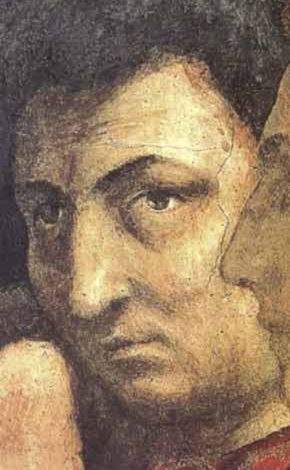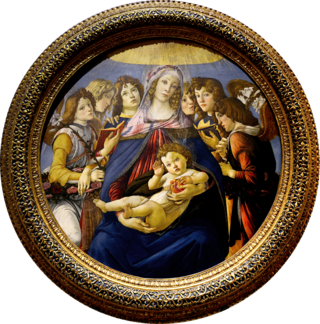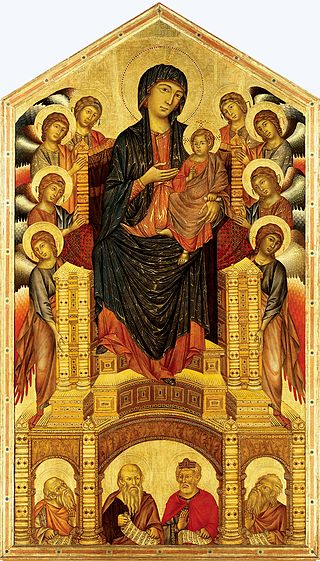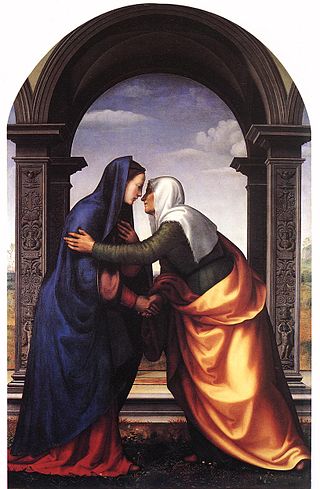History
The work was painted for the church of the convent of San Giusto alle mura together with the Pietà and a Crucifixion . Renaissance art biographer Giorgio Vasari saw them in side altars of the church of San Giovanni Battista alla Calza, after the original location had been destroyed during the Siege of Florence in 1529. It was moved to the Uffizi in the 20th century.
The dating of the work is disputed: it varies from 1482, the year of Perugino's return from Rome, to a slightly later period, although before the end of the century, when the artist started to use only line oil, which in these works is used only at an experimental level.
The painting was restored in 1998.

Masaccio, born Tommaso di Ser Giovanni di Simone, was a Florentine artist who is regarded as the first great Italian painter of the Quattrocento period of the Italian Renaissance. According to Vasari, Masaccio was the best painter of his generation because of his skill at imitating nature, recreating lifelike figures and movements as well as a convincing sense of three-dimensionality. He employed nudes and foreshortenings in his figures. This had seldom been done before him.

Alessandro di Mariano di Vanni Filipepi, known as Sandro Botticelli, was an Italian painter of the Early Renaissance. Botticelli's posthumous reputation suffered until the late 19th century, when he was rediscovered by the Pre-Raphaelites who stimulated a reappraisal of his work. Since then, his paintings have been seen to represent the linear grace of late Italian Gothic and some Early Renaissance painting, even though they date from the latter half of the Italian Renaissance period.

Filippino Lippi was an Italian painter working in Florence, Italy during the later years of the Early Renaissance and first few years of the High Renaissance.

Pietro Perugino, born Pietro Vannucci, was an Italian Renaissance painter of the Umbrian school, who developed some of the qualities that found classic expression in the High Renaissance. Raphael was his most famous pupil.

The Annunciation is a painting widely attributed to the Italian Renaissance artist Leonardo da Vinci, dated to c. 1472–1476. Leonardo's earliest extant major work, it was completed in Florence while he was an apprentice in the studio of Andrea del Verrocchio. The painting was made oil and tempera on a large poplar panel and depicts the Annunciation, a popular biblical subject in 15th-century Florence. Since 1867 it has been housed in the Uffizi in Florence, the city where it was created. Though the work has been criticized for inaccuracies in its composition, it is among the best known portrayals of the Annunciation in Christian art.

The Madonna of the Pomegranate was painted in circa 1487 with tempera on a wood panel by Sandro Botticelli. It is now in the Uffizi in Florence. Sandro Botticelli was a leading Italian Renaissance artist from Florence, Italy. The Madonna (art) uses the circular format, better known as a tondo, which focuses the attention on the main characters, the Virgin Mary and baby Jesus, who are surrounded symmetrically by angels on each side. Botticelli's use of tempera grassa give the characters a real look, better known as a "naturalistic" style, which is common during the Renaissance. The Virgin Mary is holding baby Jesus gently in her arms while holding a pomegranate in her left hand.

The Baptism of Christ is a painting finished around 1475 in the studio of the Italian Renaissance painter Andrea del Verrocchio and generally ascribed to him and his pupil Leonardo da Vinci. Some art historians discern the hands of other members of Verrocchio's workshop in the painting as well.

Florentine painting or the Florentine School refers to artists in, from, or influenced by the naturalistic style developed in Florence in the 14th century, largely through the efforts of Giotto di Bondone, and in the 15th century the leading school of Western painting. Some of the best known painters of the earlier Florentine School are Fra Angelico, Botticelli, Filippo Lippi, the Ghirlandaio family, Masolino, and Masaccio.

Italian Renaissance painting is the painting of the period beginning in the late 13th century and flourishing from the early 15th to late 16th centuries, occurring in the Italian Peninsula, which was at that time divided into many political states, some independent but others controlled by external powers. The painters of Renaissance Italy, although often attached to particular courts and with loyalties to particular towns, nonetheless wandered the length and breadth of Italy, often occupying a diplomatic status and disseminating artistic and philosophical ideas.

The Lamentation over the Dead Christ is a painting of the common subject of the Lamentation of Christ by the Italian Renaissance painter Pietro Perugino, executed in 1495 and now in the Galleria Palatina of Palazzo Pitti, Florence, Italy.

The Adoration of the Shepherds is a painting by the Italian Renaissance painter Lorenzo di Credi, dating to about 1510. It is displayed in the Uffizi Gallery of Florence.

Pietà is a painting by the Italian Renaissance artist Pietro Perugino, executed around 1483-1493, and housed in the Uffizi Gallery, Florence.

Madonna with Child Enthroned between Saints John the Baptist and Sebastian is a painting by the Italian Renaissance artist Pietro Perugino, executed in 1493, and housed in the Uffizi Gallery, Florence.

The Santa Trinita Maestà is a panel painting by the Italian medieval artist Cimabue, dating to c. 1290-1300. Originally painted for the church of Santa Trinita, Florence, where it remained until 1471, it is now housed in the Uffizi Gallery of Florence, Italy. It represents the Madonna enthroned with the Baby Jesus and surrounded by eight angels and, below, four half portraits of prophets.

The San Francesco al Prato Resurrection is a painting by the Italian Renaissance painter Pietro Perugino, dating to c. 1499. It is housed in the Pinacoteca Vaticana, Rome.

The Vallombrosa Altarpiece is a painting by the Italian Renaissance painter Pietro Perugino, dating to 1500–01. It is housed in the Accademia Gallery of Florence, Italy.

The Portrait of Francesco delle Opere is a painting by the Italian Renaissance artist Perugino, dating to 1494 and housed in the Uffizi Gallery, Florence.

Crucifixion is a painting of the Crucifixion of Christ, usually attributed to Perugino, with or without assistance from Luca Signorelli. The work's dating and attribution are both uncertain - Venturi and Schmarsow attribute it to a pupil of Perugino, whilst other art historians attribute it to Perugino alone or with assistance from Signorelli. The deep chiaroscuro is comparable to Signorelli's style elsewhere or to the early style of Perugino whilst he was still heavily influenced by Verrochio. The landscape background is typical of Perugino, with mountains and hills in deep perspective.

Visitation is a 1503 painting of the Visitation of the Virgin Mary to Elizabeth by Mariotto Albertinelli. The date is shown on both columns in the work. It is now in the Uffizi in Florence.

Apparition of the Virgin to St Bernard is an oil on wood painting by Italian artist Fra Bartolomeo, datable to 1504–1507. It is held in the Uffizi, in Florence.




















